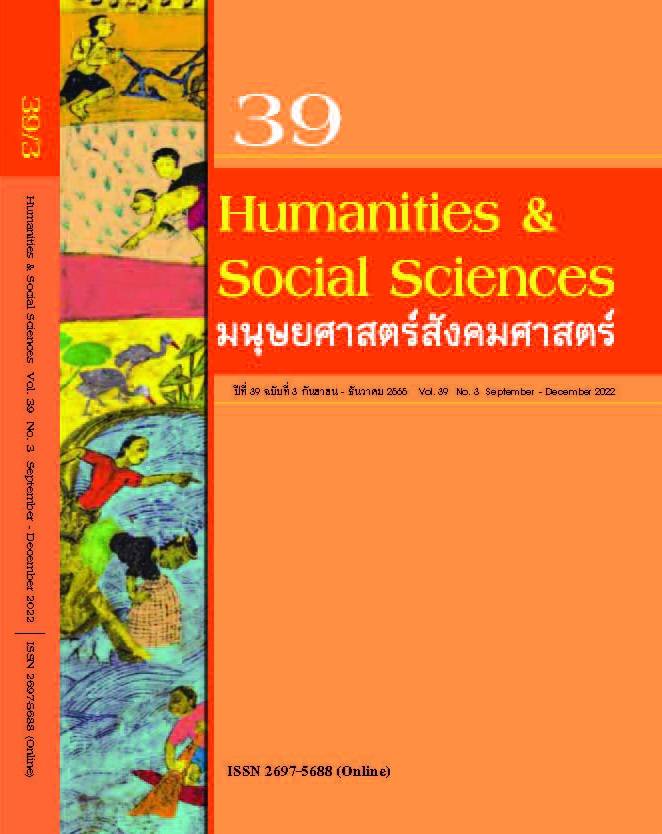การศึกษาอุปลักษณ์เชิงมโนทัศน์ [มนุษย์คือสัตว์] ในนวนิยายจีนเรื่อง หงเกาเหลียง กับฉบับแปลไทยเรื่อง ตำนานรักทุ่งสีเพลิง
A Study of Conceptual Metaphors [HUMAN IS ANIMAL] in the Chinese Novel Hong Gaoliang and its Thai Translation Tamnan Rak Tung Si Ploeng
Keywords:
Keywords: Metaphors, Conceptual metaphors, Translation strategies, Chinese-Thai translation, Red SorghumAbstract
บทคัดย่อ
งานวิจัยนี้มีวัตถุประสงค์สองประการ 1) เพื่อศึกษาอุปลักษณ์เชิงมโนทัศน์ [มนุษย์คือสัตว์] ในนวนิยายจีนเรื่อง หงเกาเหลียง และ 2) เพื่อศึกษากลวิธีการแปลเป็นภาษาไทยในฉบับแปลไทยเรื่อง ตำนานรักทุ่งสีเพลิง จากการศึกษาอุปลักษณ์เชิงมโนทัศน์ [มนุษย์คือสัตว์] จำนวน 184 ตัวอย่าง พบอุปลักษณ์เชิงมโนทัศน์ ดังนี้ [มนุษย์คือสัตว์สี่เท้า] [มนุษย์คือสัตว์น้ำและสัตว์ครึ่งบกครึ่งน้ำ] [มนุษย์คือสัตว์ปีก] และ [มนุษย์คือสัตว์เลื้อยคลานและแมลง] โดยมีการเชื่อมโยงมโนทัศน์ของสัตว์กับมนุษย์สี่ประการใหญ่ด้วยกัน ได้แก่ รูปร่างลักษณะและอากัปกิริยา ความสามารถ พฤติกรรมและนิสัยที่ดี และพฤติกรรมและนิสัยที่ไม่ดี
จากการศึกษากลวิธีการแปลอุปลักษณ์ดังกล่าวนี้ในฉบับแปลไทยพบทั้งสิ้น 7 กลวิธี เรียงตามความถี่ที่พบจากมากไปน้อย ได้แก่ การแปลเอาความ การแปลอุปลักษณ์ตรงความ การละไม่แปล การแปลอุปลักษณ์ตรงความแต่ลดข้อความบางส่วน การแทนที่ทางวัฒนธรรม การแปลอุปลักษณ์ตรงความร่วมกับการอธิบายหรือเสริมความ และการแปลอุปลักษณ์เดิมบางส่วน
คำสำคัญ: อุปลักษณ์, อุปลักษณ์เชิงมโนทัศน์, กลวิธีการแปล, การแปลจีน-ไทย, ตำนานรักทุ่งสีเพลิง
Abstract
The purposes of this study were 1) to study the conceptual metaphors [HUMAN IS ANIMAL] found in the Chinese novel Hong Gaoliang and 2) to study the translation techniques into the Thai language in its Thai translation Tamnan Rak Tung Si Ploeng. From a study conducted on a total of 184 [HUMAN IS ANIMAL] metaphor samples, the following conceptual metaphors were found: [HUMAN IS QUADRUPED], [HUMAN IS AQUATIC ANIMAL AND AMPHIBIAN], [HUMAN IS POULTRY], and [HUMAN IS REPTILE AND INSECT]. The common characteristics of the mappings of animals and humans can be divided into four groups: appearance and posture, ability, positive behaviors and habits, and negative behaviors and habits.
The translation techniques found in the Thai translation can be divided into seven types sorted by frequency from highest to lowest: free translation, reproducing the same image in the TL, deletion, reproducing the same image in the TL with text reduction, cultural substitution, reproducing the same image in the TL with sense or reinforcement, and partially literal translation.
Keywords: metaphors, conceptual metaphors, translation techniques, Chinese-Thai translation, Red Sorghum
References
ประเทืองพร วิรัชโภคี. (2557). ตำนานรักทุ่งสีเพลิง. กรุงเทพฯ : นานมีบุ๊คส์ พับลิเคชั่นส์.
ศศรักษ์ เพชรเชิดชู. (2555). การแปลจีน-ไทยเบื้องต้น. กรุงเทพฯ : โครงการเผยแพร่ผลงานวิชาการ คณะอักษรศาสตร์ จุฬาลงกรณ์มหาวิทยาลัย.
Lakoff, G and Johnson, M. (1980). Metaphors we live by. Chicago: University of Chicago Press.
Lakoff, G. (1993). The contemporary theory of metaphor. In Andrew Ortony (Ed.), Metaphor and Thought. (2nd ed., pp 202-251). Cambridge : Cambridge University Press.
Newmark, P. (1988). A Textbook of Translation. London: Prentice Hall International.
莫言. (2017). 红高粱家族(修订版). 杭州: 浙江文艺出版社.



